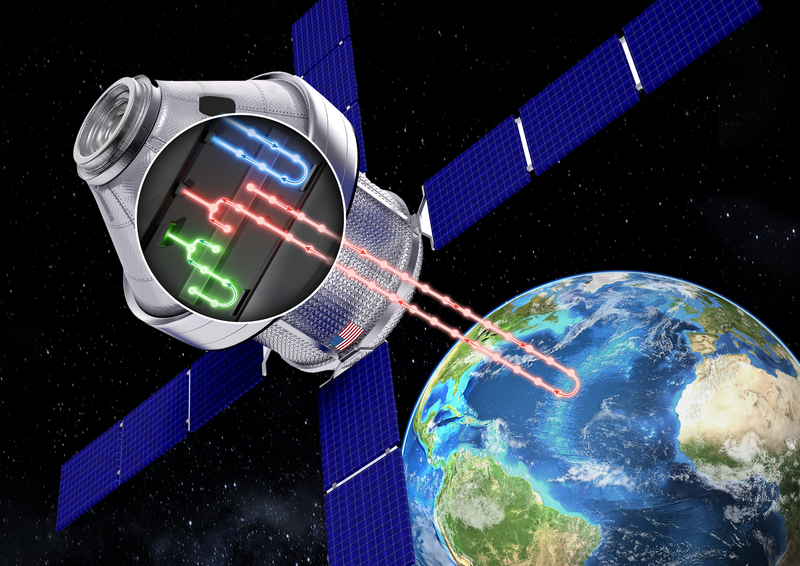Quantum Radar over Long Distances
Researchers hope to harness the quantum properties of light in order to surpass classical resolution limits when imaging objects remotely, using so-called quantum sensing. Now a researcher team has proposed a technique that could extend the useful distances of this technology from tens of meters to hundreds of kilometers [1]. The design would employ a bizarre quantum effect: the ability of light to be imprinted with information about an object even if it has never actually interacted with that object. The researchers hope to demonstrate the idea in the next few years.
Traditional remote imaging involves sending light out to an object, collecting it on reflection, and then forming an image by using the changes imprinted upon the light by the interaction. That’s how radar works. In principle, a quantum radar could produce images with resolution and sensitivity far beyond anything possible with classical physics, says Diego Dalvit of Los Alamos National Laboratory in New Mexico. In the simplest scheme, one photon of a quantum mechanically entangled pair could be sent to interact with the object, and then it could be compared with its twin that was stored during the trip. However, this approach currently works over only a few tens of meters because it relies on single photons, most of which would be absorbed in the air before they could reach a distant object. Another challenge is the practicality of storing one of the photons in a way that maintains its quantum coherence, especially for longer times.
To increase the operating distance of a quantum radar, Dalvit and colleagues propose an alternative that replaces pairs of photons with pairs of multiphoton entangled states—squeezed modes—that can survive over longer distances in air. Their approach also exploits a mind-boggling effect first demonstrated in the early 1990s. In the Zou-Wang-Mandel effect, a continuous series of entangled photon pairs—which are separated into two beams—is sent through an interferometer containing two distinct routes. Photons in the primary beam pass by an object of interest and interact with it. The interferometer, however, forms an interference pattern at a detector using only photons traveling in the secondary beam, the one containing photons that never encounter the object. Even so, this interference pattern produces an image of the object, thanks to the entanglement.
Dalvit and colleagues’ design also exploits another recent advance in quantum engineering. They plan to use a periodic train of precisely timed optical pulses called a frequency comb, whose spectrum is a “comb” of narrow, identically spaced lines. If these pulses are sent into the same type of nonlinear crystal that can convert a single photon into an entangled pair, the output is a pair of entangled frequency combs.
The strong coherence of frequency combs allows this design to dispense with the need to store photons at the source. “A pulse in one comb is always in phase with any other pulse in the same comb and with any other pulse belonging to the twin comb,” Dalvit says. In their quantum radar scheme, a returning pulse from one comb, having reflected from a target, can be associated with a new pulse of the other comb. So an image can be generated using only pulses from the comb that never interacts with the target. The storage isn’t needed because “the whole comb is storing the information,” Dalvit says.
Dalvit and colleagues hope to carry out proof-of-principle experiments in the near future. Given the achievable coherence times of frequency combs—as long as 2000 seconds—they expect to achieve quantum sensing over distances of hundreds of kilometers. And even accounting for disruptions from atmospheric turbulence and other effects, they expect to reach an imaging precision well beyond that achievable with classical sensors.
“This paper is among the most amazing I have ever seen,” says Steve Lamoreaux of Yale University, a specialist in precision measurements of fundamental processes. However, he adds that many technical issues, such as potentially unexpected effects of atmospheric turbulence, will ultimately determine the practical limitations of such a system. “So far this is a purely theoretical analysis,” Lamoreaux says, “but the fundamental idea is sound. And it brings lots of clever ideas together in a new manner.”
–Mark Buchanan
Mark Buchanan is a freelance science writer who splits his time between Abergavenny, UK, and Notre Dame de Courson, France.
References
- D. A. R. Dalvit et al., “Quantum frequency combs with path identity for quantum remote sensing,” Phys. Rev. X 14, 041058 (2024).







